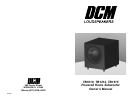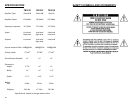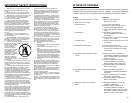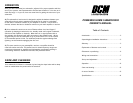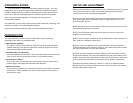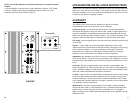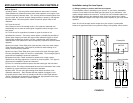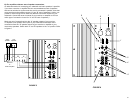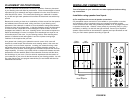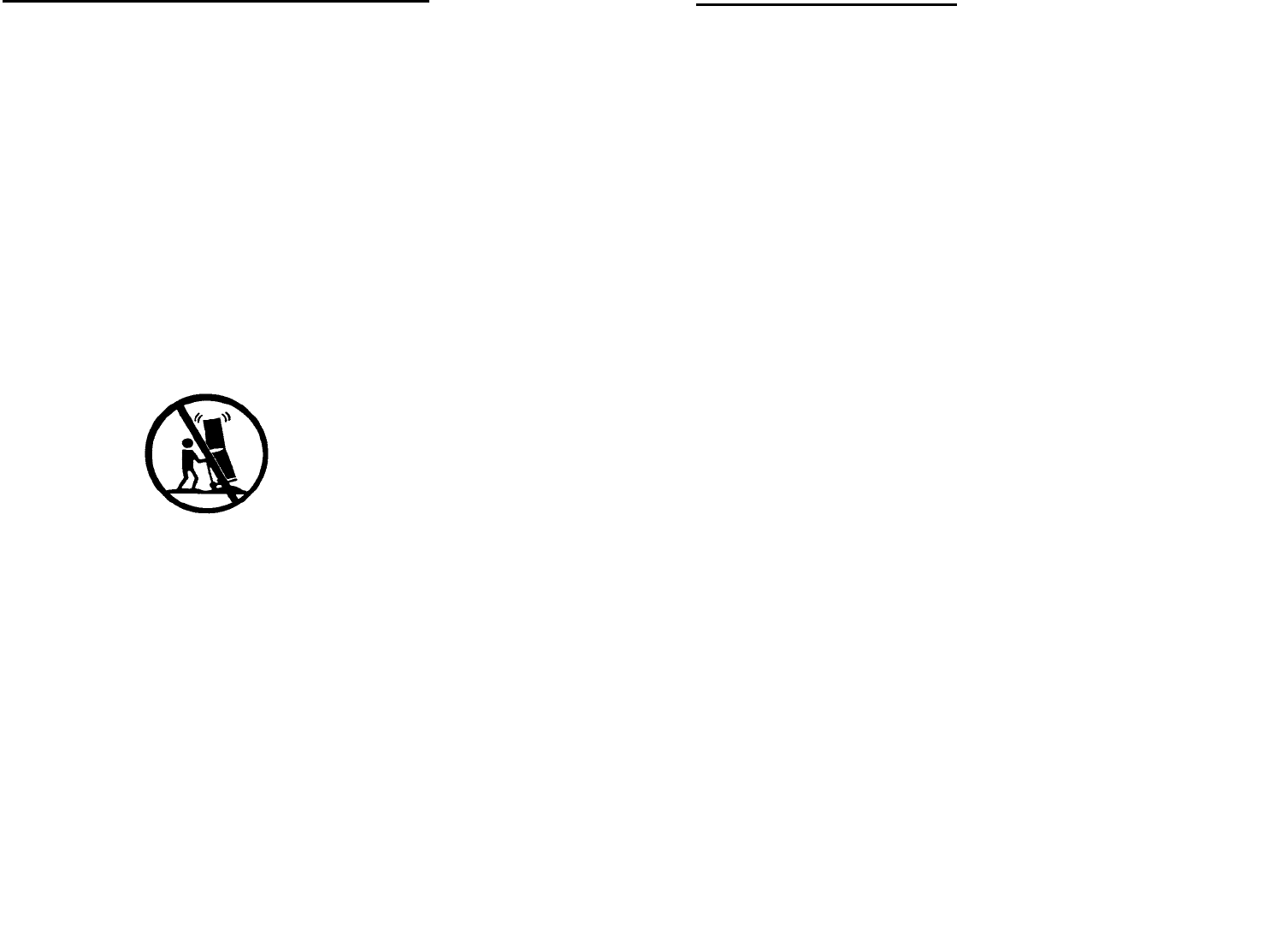
1. Read Instructions – All the safety and operating
instructions should be read before the product is
opened.
2. Retain Instructions – The safety and operating
instructions should be retained for future reference.
3. Heed Warnings – All warnings on the product and
in the operating instructions should be adhered to.
4. Follow Instructions – All operating and use
instructions should be followed.
5. Cleaning – Unplug this product from the wall
outlet before cleaning. Do not use liquid cleaners or
aerosol cleaners. Use a damp cloth for cleaning.
Exception: A product that is meant for uninterrupted
service and that for some specific reason, such as
the possibility of the loss of an authorization code for
a CATV Converter, is not intended to be unplugged
by the user for cleaning or any other purpose, may
exclude the reference to unplugging the product in the
cleaning description otherwise required in
above 5).
6. Attachments – Do not use attachments not
recommended by the product manufacturer as they
may cause hazards.
7. Water and Moisture – Do not use this product
near water – for example, near a bath tub, wash bowl,
kitchen sink, or laundry tub; in a wet basement; or
near a swimming pool; and the like.
8. Accessories – Do not place this product on an
unstable cart, stand, tripod, bracket, or table. The
product may fall, causing
serious injury to a child
or adult, and serious
damage to the product.
Use only with a cart, stand,
tripod, bracket, or table
recommended by the
manufacturer, or sold with
the product. Any mounting
of the product should
follow the manufacturer’s
instructions, and should
use a mounting accessory recommended by the
manufacturer.
9. A product and cart combination should be moved
with care. Quick stop, excessive force, and uneven
surfaces may cause the product and cart combination
to overturn.
10. Ventilation – Slots and openings in the cabinet
are provided for ventilation and to ensure reliable
operation of the product and to protect it from
overheating, and these openings must not be blocked
or covered. The openings should never be blocked
by placing the product on a bed, sofa, rug or other
similar surface. This product should not be placed in a
built-in installation such as a bookcase or rack unless
proper ventilation is provided or the manufacturer’s
instructions have been adhered to.
11. Power Sources – This product should be
operated only from the type of power source indicated
on the marking label. If you are not sure of the type
of power supply to your home, consult your product
dealer or local power company. For products intended
to operate from battery power, or other sources, refer
to the operating instructions.
12. Grounding or Polarization – This product may be
equipped with a polarized alternating-current line plug
(a plug having one blade wider than the other). This
plug will fit into the power outlet only one way. This is
a safety feature. If you are unable to insert the plug
fully into the outlet, try reversing the plug. If the plug
should still fail to fit, contact your electrician to replace
your obsolete outlet. Do not defeat the safety purpose
of the polarized plug.
13. Power-Cord Protection – Power-supply cords
should be routed so that they are not likely to be
walked on or pinched by items placed upon or against
them, paying particular attention to cords at plugs,
convenience receptacles, and the point where they
exit from the product.
15. Outdoor Antenna Grounding – If cable system is
connected to the product, be sure the cable system
is grounded so as to provide some protection against
voltage surges and built-up static charges.
16. Lightning – For added protection for this product
during a lightning storm, or when it is left unattended
and unused for long periods of time, unplug it from
the wall outlet and disconnect the antenna or cable
system. This will prevent damage to the product due
to lightning and power-line surges.
17. Overloading – Do not overload wall outlets,
extension cords, or integral convenience receptacles
as this can result in a risk of fire or electric shock.
18. Object and Liquid Entry – Never push objects of
any kind into this product through openings as they
may touch dangerous voltage points or short-out parts
that could result in a fire or electric shock. Never spill
liquid of any kind on the product.
19. Servicing – Do not attempt to service this product
yourself as opening or removing covers may expose
you to dangerous voltage or other hazards. Refer all
servicing to qualified service personnel.
20. a) When the power-supply cord or plug is
damaged.
b) If liquid has been spilled, or objects have fallen
into the product.
c) If the product has been exposed to rain or
water.
d) If the product does not operate normally by
following the operating instructions. Adjust only
those controls that are covered by the operating
instructions as an improper adjustment of other
controls may result in damage and will often
require extensive work by a qualified technician
to restore the product to its normal operation.
e) If the product has been dropped or damaged in
any way.
21. Replacement Parts – When replacement parts
are required, be sure the service technician has used
replacement parts specified by the manufacturer or
have the same characteristics as the original part.
Unauthorized substitutions may result in fire, electric
shock, or other hazards.
22. Safety Check – Upon completion of any service or
repairs to this product, ask the service technician to
perform safety checks to determine that the product is
in proper operating condition.
23. Wall or Ceiling Mounting – The product should be
mounted to a wall or ceiling only as recommended by
the manufacturer.
24. Heat – The product should be situated away from
heat sources such as radiators, heat registers, stoves,
or other products (including amplifiers) that produce
heat.
13
IN CASE OF TROUBLE
Your new subwoofer, once set-up and adjusted, should give you years of listening
enjoyment with your favorite movies and music. However, if you should experience
a problem with your unit, the following chart should help you locate the trouble:
Problem
1) Subwoofer makes loud noise at turn-on.
2) Subwoofer has no output.
a) Status LED off
b) Red light on
c) Green light on
3) Subwoofer has little output.
4) Subwoofer output is distorted at high
volume.
5) Subwoofer output is distorted at low
volume.
6) Subwoofer makes hum or buzzing
noises.
Diagnosis
A) Muting circuit is defective.
Return unit for repair.
A) Line cord is not plugged in.
B) Line fuse is blown. Unplug line cord
from wall outlet,then check fuse.
C) Internal fuse is blown. Return unit for
repair.
A) No signal is reaching the unit.
Check connections from receiver or
preamplifier.
B) Power switch is turned off. Place switch
to “auto” or “on” mode.
A) Signal is present, but level control is set
at minimum.
A) Level control is set too low.
B) If using high level inputs, right and left
channels are connected out of phase.
Check wiring.
A) Signal from receiver, amplifier, or
preamplifier is distorted from being over
driven. Reduce main system volume or
bass tone control.
B) Volume of subwoofer is too high,
causing amplifier to be over driven.
Reduce setting of input level control.
C) Subwoofer electronics are defective.
Return unit for repair.
A) Signal from receiver, amplifier, or
preamplifier is distorted from defective
electronics.
B) Signal connecting wires to subwoofer
are shorted. Check wiring.
C) Subwoofer electronics are defective.
Return unit for repair.
A) Grounding problem or ground loop
condition. Check wiring.
B) Isolate problem by removing all
connecting cables and turning up
subwoofer input level control. If noise is
still present, subwoofer electronics are
defective. Return unit for repair.
IMPORTANT SAFETY INSTRUCTIONS



